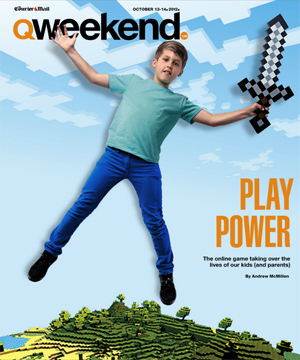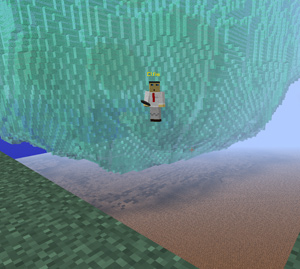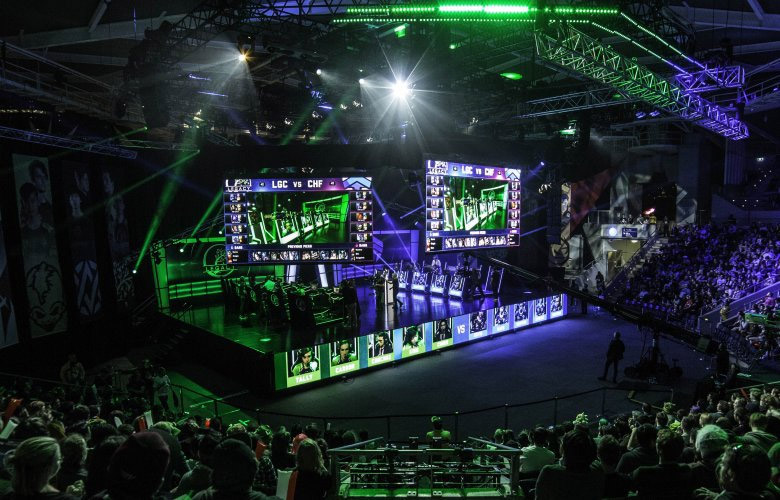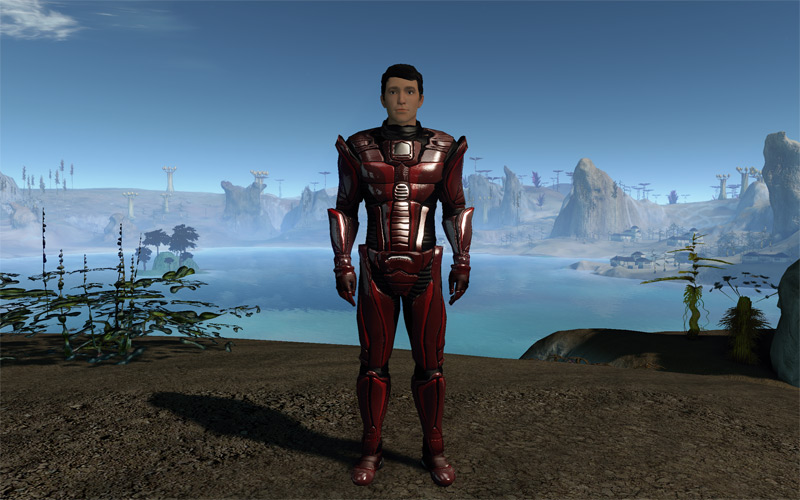Goal Mining
Story: Andrew McMillen / Photography: David Kelly
A video game that uses collaboration and communication to engage children online has inspired a new method of teaching.

The first thing we need to do is collect wood. We do this by smashing our fists into tall trees until the wood disintegrates into small blocks, which then become ours to keep. Curiously, punching out the tree trunks makes no difference to their structural integrity; they continue standing tall, trunkless, while we pilfer their wood.
The second thing we need to do is make sticks. “Using the crafting table, put one wood block on top of the other,” says James Keogh, who acts as group leader and instructs our gang of five as we navigate this strange world. Easier said than done. Under the clear blue sky, I can’t interpret his instructions to make the most obvious and essential item.
Sticks are the basis of the pickaxe, the shovel and the sword. I need all of these things to survive and prosper in the world of Minecraft, a computer game set in a randomly generated landscape of mountains, valleys, forests and deserts. Minecraft is unlike any game I’ve played – there are neither clear objectives nor clear instructions. The player is left to his own devices in this virtual playground, to spend his time however he wishes.
My fellow adventurers – four 11-year-old boys who attend West Moreton Anglican College, west of Brisbane – try time and again to explain the simple process of creating sticks. I’m sweating as oblong clouds pass across the square sun. The blocky mountains surrounding us seem to be frowning at me. Dark squid float idly in the lake nearby, indifferent to my crafting struggles.
I feel stupid and inadequate, especially in the company of these four well-travelled friends. Darcy Keogh, James’s twin brother, takes pity and gifts me a stone pickaxe, short-cutting the process considerably. It’s a relief. Without my companions, I’d be clueless; come nightfall, I’d surely be dead.
James and Darcy have been busy using their pickaxes to excavate dirt out of the side of the nearest mountain for our “hidey-hole”, while their friend Liam Catlan patiently attempts to coach some success into me. Torrin Beverley has taken it upon himself to begin digging deeper into the earth in search of precious resources like iron, gold, and – if he’s lucky – maybe even diamond. Mining tools in hand – just a pickaxe and a shovel for now – I climb partway up the mountain and stand at the entrance, admiring their handiwork.
James warns us that it’s almost night time. I step inside the hidey-hole, shutting the door behind me. Foolishly, Liam stays out and attempts to fight a giant spider. Anguished howls echo across the landscape as he dies at the fangs of his eight-legged foe. His now-itemless character respawns beside us. “Did you have anything worthwhile on you?” James asks. Two stone pickaxes, his friend types. “Not really much, then,” replies our leader nonchalantly.
Torrin asks if anyone wants a sword. “Yes,” I type, before opening the door and stepping outside. It’s snowing. Pretty, digital snowflakes criss-cross the night sky, falling lazily to the ground. “Whoa,” I say to no-one in particular. It’s a beautiful sight.
I check my inventory and find Torrin’s gift. All four boys have joined me outside, just beyond the light cast by the flames of our farthest torch. The square moon passes slowly overhead. I wonder aloud whether it’s a good idea for us to be out here, given that one member of our gang of five was so recently slain. “Not really,” says James, swinging his sword defiantly at nothing in particular.
The boys tell me that there are zombies, skeletons, Creepers, spiders and Endermen out here, prowling the dark landscape. Horrible creatures all. We head back inside and close the door behind us. I turn and stare through the window once again at the mesmerising snowflakes, reflecting on the wide range of emotions I’ve experienced during my first 20 minute-long day/night cycle: confusion, frustration, satisfaction, wonder and, finally, fear.
++
Minecraft is fun because it’s so divorced from reality that minds run free with possibility. Key attractions include its detachment from the responsibilities of daily life – school, work, parenthood, traffic, taxes – and the ease with which the digital world bends to your will. Want to dig a hole in real life? It’s bloody hard work, for starters. Then there are property rights and land ownership to consider, as well as the high likelihood of your dad going off at the sight of his well-tended lawn transformed into a crater.
 In Minecraft, though, it takes just seconds to carve into the ground, or a mountain, and begin exploring what’s beneath. (Once you’ve conquered the admittedly tricky first act of crafting your mining tools, of course.) Likewise, it’s just as easy to create solid structures in-game. Two of the most impressive mega-creations include a 1:1 scale model of the Starship Enterprise, from Star Trek, and a current project involving a few dozen people working on crafting the entire Westeros realm, from the fantasy series Game Of Thrones. Put simply, it’s Lego in a limitless virtual world where the only impediment is your imagination.
In Minecraft, though, it takes just seconds to carve into the ground, or a mountain, and begin exploring what’s beneath. (Once you’ve conquered the admittedly tricky first act of crafting your mining tools, of course.) Likewise, it’s just as easy to create solid structures in-game. Two of the most impressive mega-creations include a 1:1 scale model of the Starship Enterprise, from Star Trek, and a current project involving a few dozen people working on crafting the entire Westeros realm, from the fantasy series Game Of Thrones. Put simply, it’s Lego in a limitless virtual world where the only impediment is your imagination.
Created by 33 year-old Swedish game programmer and designer Markus Persson, best known by his online handle “Notch”, Minecraft is an international phenomenon. Notch self-published the first “alpha” version of the game online in May 2009, charging a one-off fee of about $12 (€9.95) and updating Minecraft with new features until version 1.0 was released in November 2011 for $24.50 (€19.95). More than 10 million players have bought the game across both the PC and Xbox 360 platforms; it also boasts 42 million registered users, a figure still growing by around 140,000 new players per day.
Few are immune to its charms, even those who struggle with the game’s mechanics at first – which is essentially everyone, as the PC version of the game offers no in-game assistance. (Minecraft Wiki – a popular first destination for the clueless – contains more than 2,000 detailed articles.) This is the kind of unorthodox design decision that few gaming studios or publishers would allow, yet since Notch created it all himself, he was beholden to no such orthodoxy. Evidently, it hasn’t hindered the game’s popularity.
“Younger gamers are completely enthralled by Minecraft,” says Janet Carr, series producer of ABC TV’s Good Game, which screens Tuesday nights on ABC2 and attracts an average weekly audience of 108,000. “Since you create your own fun, it gives you the freedom to play it the way you want to. It’s personally satisfying because you have that feeling of discovery, and of creation. Normal game design theory would say that making it hard to play is lethal to your game. Minecraft is the complete opposite: because the kids have to work quite hard at getting a handle on it, they get invested in it really quickly, and very deeply.”
Carr’s team also works on Good Game Spawn Point, a program aimed at gamers aged 8-12 watched by 80,000 viewers on ABC3 Saturday mornings. She estimates that half of the 10,000 emails sent to the show’s presenters each week are from younger gamers seeking answers to Minecraft gameplay questions. “It’s not even just the number of emails we get about the game that’s surprising, it’s the sophistication of the information they’re seeking,” Carr says. “It’s not, ‘how do I build a pickaxe?’ It’s ‘how do I set up my repeater units so that my mine cart will travel a few kilometres?’ Engineering questions.”
++
It’s impossible to discuss Minecraft without acknowledging its potential to become truly consuming. Since the game world is randomly generated and limitless, it’s unsurprising that those who fall for its charms tend to invest serious hours in the never-ending process of day and night, mining and crafting, exploring and expanding. “A lot of parents are concerned their kids are spending too much time on video games,” says Carr, whose youngest son was obsessed with Minecraft but has since moved on. Unlike most other games, though, Minecraft is undirected. Players must use their own intelligence, intuition and inspiration to derive enjoyment from the game, rather than relying on objectives and rewards predetermined by game designers.
“A large issue for parents is that they don’t understand what their kids are so enthusiastically raving about,” says Luke Bennett, a 49 year-old ecological consultant who lives in Castlemaine, Victoria and is the father of 11-year-old twins. “When our son first started playing, my wife and I discovered that if he played up until he went to bed, he was so mentally wired that he could not sleep. I’ve responded by letting him play, but not in large chunks of time. Minecraft is a valuable part of a complex lifestyle. You need to leaven it with the other stuff.”
Recently, Bennett and a friend set up a private online server where about ten children aged 7-12 play online together most nights. “This means my own gameplay is now more of a moderator role, rather than just purely building,” Bennett says. “We’ve set up a blog for the kids so that they can discuss differing playing styles, and resolve conflicts. The biggest issues in the game are virtual urban and environmental planning. The kids’ default response is to ask me to intervene, which has resulted in some very odd conversations at afternoon school pick-up,” he laughs. “But I think it’s great,” adds Bennett, who now tends to play late into the nights with his middle-aged friend after their kids go to bed at 9pm. “Minecraft is a game that encourages players to think, create, solve problems, engineer, train reflexes and socialise. It’s almost education-by-stealth, in the guise of a video game. It’s like hiding cauliflower in mashed potato.”
Janet Carr agrees that playing with children, rather than observing their behaviour from a bemused distance, is the best way to appreciate their enthusiasm and set limitations around gameplay. “If everyone in the household understands the rules, it doesn’t become an issue,” she says. “If you’ve got a child who’s really wanting to spend all their time talking about Minecraft, you’re almost beholden to get a great understanding of it yourself so at least you can have high levels of conversation about it, and talk about how to manage that time.”
Steven “Bajo” O’Donnell is co-host of both Good Game shows. “I hate the word ‘addictive’, because it has a negative association,” he says. “I like to use the word ‘compelling’ instead. Minecraft compels you to go back into it, and keep playing it, and keep building.”
His co-host, Stephanie “Hex” Bendixsen, agrees. “I don’t think it’s necessarily addictive in the way that [online role-playing game] World Of Warcraft is addictive, because that game offers you constant rewards for ‘X’ amount of hours that you’ve put in. Whereas Minecraft doesn’t really have any kind of reward system; it’s really about what you get out of it personally. It may be hard for people to stop playing, but that’s really due to their own experience rather than something that the game is doing.”
The Good Game hosts regularly hear from teachers who’ve had to ban the game from their schools, or allocate specific times when kids can go into the computer labs at lunchtime to play. “Some teachers use it as a system of reward: if the students get through a computing studies class, then they’re allowed to play for 15 minutes at the end, because they just can’t stop kids from playing it,” says Bendixsen. “They’ve had to try to find ways to work it into school life. Since it’s a game that doesn’t have any kind of guns or shooting, and encourages kids to be imaginative to work cooperatively, it works quite well in the classroom.”
++
High above the clouds, I’m standing on a transparent platform bathed in the orange glow of twilight. At the edge of one horizon, a square sun dips; behind me, a square moon rises. Underneath the platform is an enormous mass of blue-green. It’s the kind of view only an astronaut would see in reality: star-speckled blanket of infinite space above, stable blue marble below. Suddenly, a man in a white labcoat appears next to me. The glowing yellow text above his head reads “Elfie”. He begins giving me a virtual science lesson while showing me around his greatest Minecraft creation – an animal cell he built for his biology students.
 “The whole idea of these first platforms was to give the kids an overall picture of the cell, because it’s very hard to imagine what it looks like from the outside once you’re in there,” says 32 year-old Stephen “Elfie” Elford, who teaches science, maths and humanities at Numurkah Secondary College (enrolment: 300) in north-eastern Victoria.
“The whole idea of these first platforms was to give the kids an overall picture of the cell, because it’s very hard to imagine what it looks like from the outside once you’re in there,” says 32 year-old Stephen “Elfie” Elford, who teaches science, maths and humanities at Numurkah Secondary College (enrolment: 300) in north-eastern Victoria.
As we travel between observation decks by right-clicking on teleportation terminals, we’re getting closer to the giant blue-green mass. Its curvature is reminiscent of the human brain. On the fourth and final deck, I’m presented with the option of teleporting to four unfamiliar, scientific-sounding stations. I choose “Golgi”, the first option. Now I’m inside the giant mass, and before me is a roughly rectangular prism that represents the Golgi apparatus. Right-clicking on an information block at the edge of the platform gives a text overview of its function, written in the same straight-talking language Elford would use while standing at the head of his classroom. “This is an animal cell,” says Elford. “As my biology students tour the cell, they fill in a booklet. I wanted to deepen that understanding and give them a good visual representation they could call on, when needed.”
So Elford invested six months, on and off, in creating this three dimensional, to-scale replica of how he understands the inside of an animal cell might look. He estimates that he’s moved two million virtual blocks during the 50-hour building process. The brightly-coloured textures of this fascinating structure bear little resemblance to the lifelike shades of the world I explored with the four 11-year-old boys.
Elford’s animal cell is a remarkable, inspired piece of work from Australia’s foremost expert on MinecraftEdu, a modification (or “mod”) based on the existing game engine. Developed in collaboration by teachers in Finland and the United States, the mod’s disparate but growing network of Games-Based Learning practitioners see efforts like Elford’s as a way to engage the next generation of “digital native” students. (Elford runs a blog called “MinecraftEdu Elfie” where he shares his learning experiences with teachers throughout the world. He has also uploaded dozens of videos to YouTube showing how his classes have interacted with the game.)
For the last eight years, Elford had taught Nurmurkah’s science students about animal cells from the textbook, two or three times a year. “I was kind of over it,” he reflects. “I don’t know if it was a seven-year itch a year late; I just didn’t feel like I was enjoying myself. And then this came along, and now I’m enjoying my job again. It’s given me that little bump to keep going.”
Rather than learning through Elford’s descriptions and the biology textbook, it’s much more engaging for students to see his scientifically accurate representation of an animal cell with their own eyes. I didn’t take any science subjects in senior high school, partly because it all seemed so dry and dull. Had MinecraftEdu existed when I started year 11 in 2004, though, I could well have been drawn in by the technological lure.
Elford is the first to admit that fanciful creations like this won’t entirely replace traditional teaching methods. In fact, he has used this incredible virtual environment in-class once so far, for a total of two hours. He has plans to upload the map so that other teachers can use the animal cell in their own classes. “The time and effort I put in is far outweighed by the students’ immersion in this cell,” Elford says. Using the game, he’s also led students through reaction time experiments; he’s explained the transformation between solids, liquids and gases (by setting his students on fire, in-game, of course); and he’s run an assignment wherein students built energy-efficient houses, then recorded video tours of their new creations. Despite these breakthroughs, MinecraftEdu is only used on occasion at Nurmurkah, when it’s appropriate to the learning at hand.
“Personally, I think it should be in every school,” says Elford as he wraps up his tour of the animal cell while we stand outside, gazing up at the monolith. “The opportunities it provides for students to create, and to be creative, is something I haven’t found anywhere else in my time as a teacher.”
Meanwhile, 15km north-west of Cairns at Kamerunga in far North Queensland is Peace Lutheran College, a prep-to-year-12 school of 585 students. Andrew Wright, 40, is eLearning mentor at Peace. He’s the one who drove the college’s IT department to adopt MinecraftEdu for the first time this term, across two classes of 25 students. “It’s been fantastic,” says Wright, who also teaches Year 7. “We’re studying Ancient Rome at the moment. We found a MinecraftEdu map of that, where the pupils started off in the Colosseum, then partnered up and walked around Rome to have their photographs taken outside iconic landmarks such as the Pantheon. They then went away and researched what that real building would have been used for, and made a presentation about it. You walk around [the virtual] Rome yourself and you think, ‘wow, someone must have spent years doing this!’”
Though a classroom of 25 kids running rampant in MinecraftEdu sounds chaotic – despite the availability of teacher-only crowd control tools that can instantly freeze, mute or teleport students – Wright assures me it’s quite the opposite. “Because the students want to be learning, and they want to be engaged, they’re very respectful of the game and of each other,” he says. “That’s what we try and teach them – within the game, you have to cooperate, you have to use all the skills that you’d need in the real world. Collaboration, communication; it’s all there. There’s a real learning curve going on because the Year 7s are teaching the Year 1s.”
Wright, who is now in his fifth year of teaching at Peace, says that “addictive” is “a strong word” when used in the context of Minecraft. “As a teacher, if you’ve got something that the students are keen on using, and you can use it in an educational way, you’re on to a winner. It can be seen as taking up a lot of time, but as with anything, you have to manage that time. When parents see their children coming home and working on this stuff after doing their homework, I don’t think you can put a value on that.”
++
James and Darcy Keogh are showing me around their virtual world one week before my first in-game experience. It’s the first time I’ve seen Minecraft in action. James walks through their well-tended farm of pumpkins, melons, wheat, sugar cane and cacti while playing on a laptop that’s connected to a widescreen television in the living room of a house in Chuwar, about 6km north-west of Ipswich.
Parents Robert and Grace, who are separated, watch intently from the lounge as their 11-year-old sons walk them through a world they understand a fraction as well as their youngest children do. Throughout the 90 minutes the twins spend pumping me with information, they chatter constantly, challenging one another on which elements of the game to demonstrate and how best to describe its complex functions. It’s a dizzyingly detailed language spoken by twins fluent in Minecraft-speak.
“There are different ranks of tools,” James explains. “You start with wooden, which is the worst, then upgrade to stone, iron, gold and diamond.”
“But you’ve got to mine all that stuff to make it,” says Robert, who has himself dabbled with the game.
“You’ve got to chop down the trees to get the wood,” Grace adds. “That’s the first thing you do – punch a tree. I never got past wooden tools,” she says, with a hint of regret.
“When you play, you just muck around,” James gently cajoles her, “putting blocks down anywhere …”
“You’re not fanatical like some!” Robert interjects. The Keogh family laughs together.
Countless hours sunk into this intriguing world built on blocks, mining and crafting. Millions of players absorbed by the limitless promise of what this game represents better than any before it – a tangible, tantalising sensation of freedom. Two 11-year-old boys who have been playing video games as long as they can remember, and who have played this particular game practically daily since their eldest brother, Brendan, first showed it to them in 2009.
“So why do you guys play?” their father asks.
“Because it’s creating, and you can basically do anything you want to,” replies James.
“Where most games are just, ‘you do this, then you do that …’” says Darcy, “and you don’t get to …” James interrupts by finding the right word for his twin.
“Most games are linear,” James says. “Minecraft isn’t linear.”











